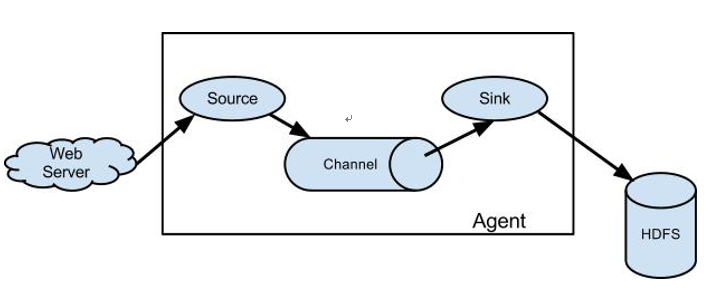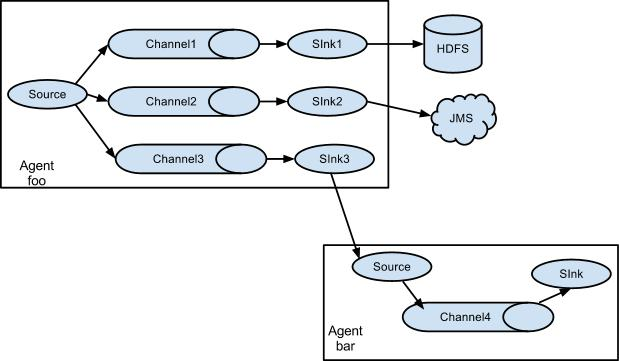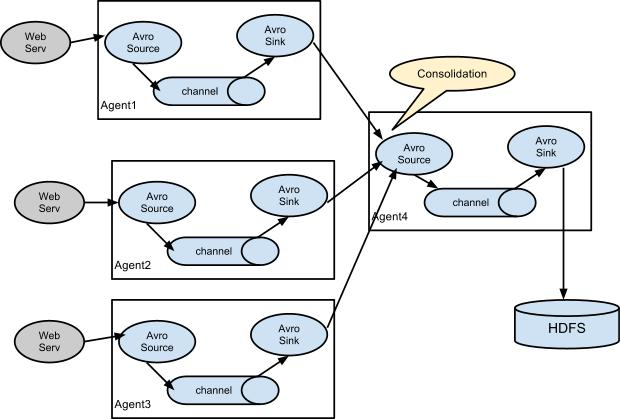一、 Flume 简介
案例场景1:
公司使用python爬虫,从网上爬取了3T的数据存储到本地磁盘中,而且每天都会增加。那么这样会产生一个问题,磁盘会面临容量瓶颈,存不下了!!那么怎么办呢?
解决方案一:使用hadoop 的put 命令或者书写mapreduce,来把数据剪切到HDFS中。
这个方案的好处就是利用了hadoop的hdfs可以存储大量数据的好处,弊端就是,假设爬虫实时爬取的数据很大,那么在转移数据到hdfs之前,马上就达到了瓶颈,那么就会出现问题。而且使用这种方案,一次性转移大量的数据,可能会使得hadoop崩溃等等。
Flume\ 就是能够解决这个问题,实时的进行数据采集保存到hdfs***。***
1) Flume 提供一个分布式的,可靠的,对大数据量的日志进行高效收集、聚集、移动的服务,
Flume 只能在 Unix 环境下运行。
2) Flume 基于流式架构,容错性强,也很灵活简单。
3) Flume、Kafka 用来实时进行数据收集,Spark、Storm 用来实时处理数据,使用MR或者Hive处理离线数据,impala 用来实时查询。
Flume***和* *Kafka**都是可以实时进行数据采集,那么他们两个的区别是什么呢?flume适合操作存储在**磁盘上的实时数据**,kafka适合操作保存在**内存中的实时数据***
二、Flume 角色

2.1、Source
用于采集数据,Source 是产生数据流的地方,同时 Source 会将产生的数据流传输到 Channel,
这个有点类似于 Java IO 部分的 Channel。
2.2、Channel
用于桥接 Sources 和 Sinks,类似于一个队列。
2.3、Sink
从 Channel 收集数据,将数据写到目标源(可以是下一个 Source,也可以是 HDFS 或者 HBase)。
2.4、Event
传输单元,Flume 数据传输的基本单元,以事件的形式将数据从源头送至目的地。
三、Flume 传输过程
source 监控某个文件或数据流,数据源产生新的数据,拿到该数据后,将数据封装在一个
Event 中,并 put 到 channel 后 commit 提交,channel 队列先进先出,sink 去 channel 队列中
拉取数据,然后写入到 HDFS 中。
四、Flume 部署及使用
4.1、文件配置
flume-env.sh 涉及修改项:
|
4.1.1 关于文件夹中的cdh版本的flume

这个版本和apache官方发行的flume有什么区别呢?

Clodera发布的cdh版本,里面包含了关于大数据一整套常用的资源。例如上面的cdh就包含了

他这么做的目的就是为了适配各个***hadoop**常用框架之间的兼容性,能够保证这里面的版本使用起来没有问题***
但是如果单独使用apache发行的flume,那么可能会和其他hadoop框架发生不兼容问题,需要自己去解决。例如flume1.7 跟 hadoop3.0 就会不兼容
4.2、案例
4.2.1、案例一:监控端口数据
目标:Flume 监控一端 Console,另一端 Console 发送消息,使被监控端实时显示。
分步实现:
1) 安装 telnet 工具 (rpm 需要事先下载,在有网的环境下可以通过yum下载)
$ sudo rpm -ivh xinetd-2.3.14-40.el6.x86_64.rpm
$ sudo rpm -ivh telnet-0.17-48.el6.x86_64.rpm
$ sudo rpm -ivh telnet-server-0.17-48.el6.x86_64.rpm
2) 创建 Flume Agent 配置文件 flume-telnet.conf
具体配置意义推荐查看官方文档:第一部门,定义agent相关信息,source和sink以及channels的名称(不能够重复)
第二部分:定义source
第三部门:定义sink的输出位置
第四部门:定义channel
第五部分:source绑定channel和sink绑定channel。
a1.sources.r1.channels 可以看到这里是复数channel,表示source可以绑定多个channel。然后一个channel只能够绑定一个sink,只能够有一个输出
al 表示的是 整个agent的别名 – 必须是唯一的\一因为你可能同时启动了多个flume任务,那么如果agent的id不是唯一,就会出现数据紊乱
r1 和 k1 分别是 source和sink的id,只要在当前agent内保证不相同即可,没有类似***agent**的**id**全局唯一的要求***
|
3) 判断 44444 端口是否被占用
$ netstat -tunlp | grep 44444
4) 先开启 flume 先听端口(启动后会挂在哪里,需要打开另一个窗口发送数据)
$ bin/flume-ng agent –conf conf/ –name a1 –conf-file job/flume-telnet.conf
-Dflume.root.logger==INFO,console
5) 使用 telnet 工具向本机的 44444 端口发送内容
$ telnet localhost 44444
4.2.2、案例二:实时读取本地文件到 HDFS
目标:实时监控 hive 日志,并上传到 HDFS 中
分步实现:
1) 拷贝 Hadoop 相关 jar 到 Flume 的 lib 目录下(要学会根据自己的目录和版本查找 jar 包**)**
$ cp share/hadoop/common/lib/hadoop-auth-2.5.0-cdh5.3.6.jar ./lib/ $ cp share/hadoop/common/lib/commons-configuration-1.6.jar ./lib/
$ cp share/hadoop/mapreduce1/lib/hadoop-hdfs-2.5.0-cdh5.3.6.jar ./lib/ $ cp share/hadoop/common/hadoop-common-2.5.0-cdh5.3.6.jar ./lib/
$ cp ./share/hadoop/hdfs/lib/htrace-core-3.1.0-incubating.jar ./lib/
$ cp ./share/hadoop/hdfs/lib/commons-io-2.4.jar ./lib/
尖叫提示:标红的 jar 为 1.99 版本 flume 必须引用的 jar
2) 创建 flume-hdfs.conf 文件
# Name the components on this agent a2.sources = r2
a2.sinks = k2
a2.channels = c2
# Describe/configure the source
a2.sources.r2.type = exec
a2.sources.r2.command = tail -F /home/admin/modules/apache-hive-1.2.2-bin/hive.log
a2.sources.r2.shell = /bin/bash –c //执行上述command的命令前缀是/bin/bash –c
# Describe the sink a2.sinks.k2.type = hdfs
a2.sinks.k2.hdfs.path = hdfs://linux01:8020/flume/%Y%m%d/%H
#上传文件的前缀
a2.sinks.k2.hdfs.filePrefix = logs-
#是否按照时间滚动文件夹
a2.sinks.k2.hdfs.round = true
#多少时间单位创建一个新的文件夹
a2.sinks.k2.hdfs.roundValue = 1
#重新定义时间单位
a2.sinks.k2.hdfs.roundUnit = hour
#是否使用本地时间戳
a2.sinks.k2.hdfs.useLocalTimeStamp = true
#积攒多少个 Event 才 flush 到 HDFS 一次
a2.sinks.k2.hdfs.batchSize = 1000
#设置文件类型,可支持压缩
a2.sinks.k2.hdfs.fileType = DataStream
#多久生成一个新的文件
a2.sinks.k2.hdfs.rollInterval = 600
#设置每个文件的滚动大小
a2.sinks.k2.hdfs.rollSize = 134217700
#文件的滚动与 Event 数量无关
a2.sinks.k2.hdfs.rollCount = 0
#最小冗余数
a2.sinks.k2.hdfs.minBlockReplicas = 1
# Use a channel which buffers events in memory a2.channels.c2.type = memory
a2.channels.c2.capacity = 1000
a2.channels.c2.transactionCapacity = 100
# Bind the source and sink to the channel
a2.sources.r2.channels = c2
a2.sinks.k2.channel = c2
为什么要指定 a2.sources.r2.shell 因为我们知道我们在执行linux命令的时候,例如cat xxx.txt
实际上完整的命令应该是 /bin/bash –c cat xxx.txt. 因为linux 系统已经帮我们配置好了所以不需要显式输入。但是我们知道可能每台linux 的环境变量配置都不一样,那么所以需要显式指定bash地址
3) 执行监控配置
$ bin/flume-ng agent –conf conf/ –name a2 –conf-file job/flume-hdfs.conf
4.2.3、案例三:实时读取目录文件到 HDFS
目标:使用 flume 监听整个目录的文件
分步实现:
1) 创建配置文件 flume-dir.conf
a3.sources = r3
a3.sinks = k3
a3.channels = c3
# Describe/configure the source a3.sources.r3.type = spooldir
a3.sources.r3.spoolDir = /home/admin/modules/apache-flume-1.7.0-bin/upload
a3.sources.r3.fileSuffix = .COMPLETED //上传完后 upload目录下的文件后缀加上.COMPLETED
a3.sources.r3.fileHeader = true
#忽略所有以.tmp 结尾的文件,不上传
a3.sources.r3.ignorePattern = ([^ ]*.tmp)
# Describe the sink a3.sinks.k3.type = hdfs
a3.sinks.k3.hdfs.path = hdfs://linux01:8020/flume/upload/%Y%m%d/%H
#上传文件的前缀
a3.sinks.k3.hdfs.filePrefix = upload-
#是否按照时间滚动文件夹
a3.sinks.k3.hdfs.round = true
#多少时间单位创建一个新的文件夹
a3.sinks.k3.hdfs.roundValue = 1
#重新定义时间单位
a3.sinks.k3.hdfs.roundUnit = hour
#是否使用本地时间戳
a3.sinks.k3.hdfs.useLocalTimeStamp = true
#积攒多少个 Event 才 flush 到 HDFS 一次
a3.sinks.k3.hdfs.batchSize = 100
#设置文件类型,可支持压缩
a3.sinks.k3.hdfs.fileType = DataStream
#多久生成一个新的文件
a3.sinks.k3.hdfs.rollInterval = 600
#设置每个文件的滚动大小大概是 128M
a3.sinks.k3.hdfs.rollSize = 134217700
#文件的滚动与 Event 数量无关
a3.sinks.k3.hdfs.rollCount = 0
#最小冗余数
a3.sinks.k3.hdfs.minBlockReplicas = 1
# Use a channel which buffers events in memory a3.channels.c3.type = memory
a3.channels.c3.capacity = 1000
a3.channels.c3.transactionCapacity = 100
# Bind the source and sink to the channel
a3.sources.r3.channels = c3
a3.sinks.k3.channel = c3
2) 执行测试:执行如下脚本后,请向 upload 文件夹中添加文件试试
$ bin/flume-ng agent –conf conf/ –name a3 –conf-file job/flume-dir.conf
尖叫提示: 在使用 Spooling Directory Source 时
1) 不要在监控目录中创建并持续修改文件
2) 上传完成的文件会以.COMPLETED 结尾
3) 被监控文件夹每 500 毫秒扫描一次文件变动
4.2.4、案例四:Flume 与 Flume 之间数据传递:单 Flume 多 Channel、Sink,

目标:使用 flume-1 监控文件变动,flume-1 将变动内容传递给 flume-2,flume-2 负责存储到HDFS。同时 flume-1 将变动内容传递给 flume-3,flume-3 负责输出到。local filesystem。
分步实现:
1) 创建 flume-1.conf,用于监控 hive.log 文件的变动,同时产生两个 channel 和两个 sink 分别输送给 flume-2 和 flume3:
|
2) 创建 flume-2.conf,用于接收 flume-1 的 event,同时产生 1 个 channel 和 1 个 sink,将数据输送给 hdfs:
# Name the components on this agent a2.sources = r1
a2.sinks = k1
a2.channels = c1
# Describe/configure the source
a2.sources.r1.type = avro
a2.sources.r1.bind = linux01
a2.sources.r1.port = 4141
# Describe the sink a2.sinks.k1.type = hdfs
a2.sinks.k1.hdfs.path = hdfs://linux01:8020/flume2/%Y%m%d/%H
#上传文件的前缀
a2.sinks.k1.hdfs.filePrefix = flume2-
#是否按照时间滚动文件夹
a2.sinks.k1.hdfs.round = true
#多少时间单位创建一个新的文件夹
a2.sinks.k1.hdfs.roundValue = 1
#重新定义时间单位
a2.sinks.k1.hdfs.roundUnit = hour
#是否使用本地时间戳
a2.sinks.k1.hdfs.useLocalTimeStamp = true
#积攒多少个 Event 才 flush 到 HDFS 一次
a2.sinks.k1.hdfs.batchSize = 100
#设置文件类型,可支持压缩
a2.sinks.k1.hdfs.fileType = DataStream
#多久生成一个新的文件
a2.sinks.k1.hdfs.rollInterval = 600
#设置每个文件的滚动大小大概是 128M
a2.sinks.k1.hdfs.rollSize = 134217700
#文件的滚动与 Event 数量无关
a2.sinks.k1.hdfs.rollCount = 0
#最小冗余数
a2.sinks.k1.hdfs.minBlockReplicas = 1
# Describe the channel
a2.channels.c1.type = memory
a2.channels.c1.capacity = 1000
a2.channels.c1.transactionCapacity = 100
# Bind the source and sink to the channel a2.sources.r1.channels = c1
a2.sinks.k1.channel = c1
3) 创建 flume-3.conf,用于接收 flume-1 的 event,同时产生 1 个 channel 和 1 个 sink,将数据输送给本地目录:
# Name the components on this agent a3.sources = r1
a3.sinks = k1
a3.channels = c1
# Describe/configure the source
a3.sources.r1.type = avro
a3.sources.r1.bind = linux01
a3.sources.r1.port = 4142
# Describe the sink
a3.sinks.k1.type = file_roll
a3.sinks.k1.sink.directory = /home/admin/Desktop/flume3
# Describe the channel
a3.channels.c1.type = memory
a3.channels.c1.capacity = 1000
a3.channels.c1.transactionCapacity = 100
# Bind the source and sink to the channel a3.sources.r1.channels = c1
a3.sinks.k1.channel = c1
尖叫提示:输出的本地目录必须是已经存在的目录,如果该目录不存在,并不会创建新的目录
4) 执行测试:分别开启对应 flume-job(依次启动 flume-1,flume-2,flume-3),同时产生文件变动并观察结果:
|
4.2.5、案例五:Flume 与 Flume 之间数据传递,多 Flume 汇总数据到单 Flume

目标:flume-1 监控文件 hive.log,flume-2 监控某一个端口的数据流,flume-1 与 flume-2 将数据发送给 flume-3,flume3 将最终数据写入到 HDFS。
分步实现:
1) 创建 flume-1.conf,用于监控 hive.log 文件,同时 sink 数据到 flume-3:
# Name the components on this agent a1.sources = r1
a1.sinks = k1
a1.channels = c1
# Describe/configure the source
a1.sources.r1.type = exec
a1.sources.r1.command = tail -F /home/admin/modules/apache-hive-1.2.2-bin/hive.log
a1.sources.r1.shell = /bin/bash -c
# Describe the sink
a1.sinks.k1.type = avro
a1.sinks.k1.hostname = linux01
a1.sinks.k1.port = 4141
# Describe the channel
a1.channels.c1.type = memory
a1.channels.c1.capacity = 1000
a1.channels.c1.transactionCapacity = 100
# Bind the source and sink to the channel a1.sources.r1.channels = c1
a1.sinks.k1.channel = c1
2) 创建 flume-2.conf,用于监控端口 44444 数据流,同时 sink 数据到 flume-3:
# Name the components on this agent a2.sources = r1
a2.sinks = k1
a2.channels = c1
# Describe/configure the source
a2.sources.r1.type = netcat
a2.sources.r1.bind = linux01
a2.sources.r1.port = 44444
# Describe the sink
a2.sinks.k1.type = avro
a2.sinks.k1.hostname = linux01
a2.sinks.k1.port = 4141
# Use a channel which buffers events in memory a2.channels.c1.type = memory
a2.channels.c1.capacity = 1000
a2.channels.c1.transactionCapacity = 100
# Bind the source and sink to the channel
a2.sources.r1.channels = c1
a2.sinks.k1.channel = c1
3) 创建 flume-3.conf,用于接收 flume-1 与 flume-2 发送过来的数据流,最终合并后 sink 到
HDFS:
# Name the components on this
agent a3.sources = r1
a3.sinks = k1
a3.channels = c1
# Describe/configure the source
a3.sources.r1.type = avro
a3.sources.r1.bind = linux01
a3.sources.r1.port = 4141
# Describe the sink a3.sinks.k1.type = hdfs
a3.sinks.k1.hdfs.path = hdfs://linux01:8020/flume3/%Y%m%d/%H
#上传文件的前缀
a3.sinks.k1.hdfs.filePrefix = flume3-
#是否按照时间滚动文件夹
a3.sinks.k1.hdfs.round = true
#多少时间单位创建一个新的文件夹
a3.sinks.k1.hdfs.roundValue = 1
#重新定义时间单位
a3.sinks.k1.hdfs.roundUnit = hour
#是否使用本地时间戳
a3.sinks.k1.hdfs.useLocalTimeStamp = true
#积攒多少个 Event 才 flush 到 HDFS 一次
a3.sinks.k1.hdfs.batchSize = 100
#设置文件类型,可支持压缩
a3.sinks.k1.hdfs.fileType = DataStream
#多久生成一个新的文件
a3.sinks.k1.hdfs.rollInterval = 600
#设置每个文件的滚动大小大概是 128M
a3.sinks.k1.hdfs.rollSize = 134217700
#文件的滚动与 Event 数量无关
a3.sinks.k1.hdfs.rollCount = 0
#最小冗余数
a3.sinks.k1.hdfs.minBlockReplicas = 1
# Describe the channel
a3.channels.c1.type = memory
a3.channels.c1.capacity = 1000
a3.channels.c1.transactionCapacity = 100
# Bind the source and sink to the channel
a3.sources.r1.channels = c1
a3.sinks.k1.channel = c1
4) 执行测试:分别开启对应 flume-job(依次启动 flume-1,flume-2,flume-3),同时产生文件变动并观察结果:
|
尖叫提示:测试时记得启动 hive 产生一些日志,同时使用 telnet 向 44444 端口发送内容,如:
|
l 数据追加到一个文件中***(**注意:数据的存入是无序的,也就是说在某个时间点**flume1**存入**flume3**的数据可能早于**flume2**,反之亦然**—**数据交叉存放**)**,如果设置了滚动时间等等其他参数,那么条件一到就会在**hdfs**生成新的文件来进行存储***
解决***flume**之间数据输入不按照顺序的问题,利用**kafka**的队列即可。**Flume**先把数据输入到**kafka**中再输入到**flume**然后进行保存***
五、Flume 监控之 Ganglia
5.1 Ganglia 的安装与部署
1) 安装 httpd 服务与 php
# yum -y install httpd php
2) 安装其他依赖
# yum -y install rrdtool perl-rrdtool rrdtool-devel
# yum -y install apr-devel
3) 安装 ganglia
# rpm -Uvh http://dl.fedoraproject.org/pub/epel/6/x86_64/epel-release-6-8.noarch.rpm
# yum -y install ganglia-gmetad //这个相当于ganglia的服务端
# yum -y install ganglia-web //服务端的信息展示web界面
# yum install -y ganglia-gmond //相当于客户端 – 可以启动多个客户端,数据会发布到服务端,可以通过这个特性实现分布式
4) 修改配置文件文件 ganglia.conf**:**
# vi /etc/httpd/conf.d/ganglia.conf
修改为:
#
# Ganglia monitoring system php web frontend – 配置文件是配置,允许那些主机访问ganglia服务器
#
Alias /ganglia /usr/share/ganglia
Order deny,allow
Deny from all
Allow from all # 表示允许所有主机访问 – 默认是只允许本机
# Allow from 127.0.0.1
# Allow from ::1
# Allow from .example.com
文件 gmetad.conf**: 主节点 - 需要注意的是 gmetad.conf不一定在/etc/ganglia/这个目录下,因为上面我们是使用yum自动安装,默认保存在这个位置,**如果手动安装则以你设置路径为主
# vi /etc/ganglia/gmetad.conf
修改为:第二个参数表示,当前ganglia集群名称,以及主句所在服务器ip
data_source “linux” 192.168.216.20
文件 gmond.conf**:从节点 从节点向主节点发送信息的相关配置**
# vi /etc/ganglia/gmond.conf
修改为:
cluster {
name = “linux”
owner = “unspecified”
latlong = “unspecified”
url = “unspecified”
}
udp_send_channel {
#bind_hostname = yes # Highly recommended, soon to be default.
# This option tells gmond to use a source address
# that resolves to the machine’s hostname. Without
# this, the metrics may appear to come from any
# interface and the DNS names associated with
# those IPs will be used to create the RRDs.
# mcast_join = 239.2.11.71 #这个意思是使用广播的形式发送数据到ganglia集群-我们下面使用单播形式
host = 192.168.216.20
port = 8649
ttl = 1
}
udp_recv_channel {
# mcast_join = 239.2.11.71 port = 8649
bind = 192.168.216.20 retry_bind = true
# Size of the UDP buffer. If you are handling lots of metrics you really
# should bump it up to e.g. 10MB or even higher.
# buffer = 10485760
}
文件 config**:(如果不配置这个selinux linux的安全子系统,那么我们在第六步访问web时会提示权限不足)**
# vi /etc/selinux/config
修改为:
# This file controls the state of SELinux on the system.
# SELINUX= can take one of these three values:
# enforcing - SELinux security policy is enforced.
# permissive - SELinux prints warnings instead of enforcing.
# disabled - No SELinux policy is loaded. SELINUX=disabled
# SELINUXTYPE= can take one of these two values:
# targeted - Targeted processes are protected,
# mls - Multi Level Security protection. SELINUXTYPE=targeted
尖叫提示:selinux 本次生效关闭必须重启,如果此时不想重启,可以临时生效之:
$ sudo setenforce 0
不配置此项时***,**访问**gangliaweb**报错***
5) 启动 ganglia
$ sudo service httpd start
$ sudo service gmetad start
$ sudo service gmond start
6) 打开网页浏览 ganglia 页面
http://192.168.216.20/ganglia
尖叫提示:如果完成以上操作依然出现权限不足错误,请修改/var/lib/ganglia 目录的权限:
$ sudo chmod -R 777 /var/lib/ganglia
5.2 操作 Flume 测试监控
监控类型 ganglia – 默认值
汇报信息的ip和端口 – 就是刚才在主节点配置的
1) 修改 flume-env.sh 配置:
export JAVA_OPTS=”-Dflume.monitoring.type=ganglia
-Dflume.monitoring.hosts=192.168.216.20:8649
-Xms100m
-Xmx200m”
2) 启动 flume 任务
$ bin/flume-ng agent \
–conf conf/ \
–name a1 \
–conf-file job/group-job0/flume-telnet.conf \
-Dflume.root.logger==INFO,console \
-Dflume.monitoring.type=ganglia \
-Dflume.monitoring.hosts=192.168.216.20:8649
后两个参数其实可以去掉,因为刚才我们在flume-env.sh 已经配置**,这里的配置原因是想覆盖配置文件里面配置的ip和端口号,**以当前为准
3) 发送数据观察 ganglia 监测图
$ telnet localhost 44444
样式如图:
图例说明:
| 字段(图表名称) | 字段含义 | |||
|---|---|---|---|---|
| EventPutAttemptCount | source 尝试写入 channel 的事件总数量 | |||
| EventPutSuccessCount | 成功写入 channel 且提交的事件总数量 | |||
| EventTakeAttemptCount | sink 尝试从 channel 拉取事件的总数量。这不 | |||
| 意味着每次事件都被返回,因为 sink 拉取的 | ||||
| 时候 channel 可能没有任何数据。 | ||||
| EventTakeSuccessCount | sink 成功读取的事件的总数量 | |||
| StartTime | channel 启动的时间(毫秒) | |||
| StopTime | channel 停止的时间(毫秒) | |||
| ChannelSize | 目前 channel 中事件的总数量 | |||
| ChannelFillPercentage | channel 占用百分比 | |||
| ChannelCapacity | channel 的容量 | |||
六、练习
目标:
1) flume-1 监控 hive.log 日志,flume-1 的数据传送给 flume-2,flume-2 将数据追加到本地文件,同时将数据传输到 flume-3。
2) flume-4 监控本地另一个自己创建的文件 any.txt,并将数据传送给 flume-3。
3) flume-3 将汇总数据写入到 HDFS。
请先画出结构图,再开始编写任务脚本。

